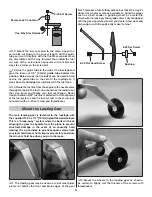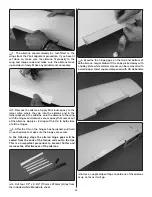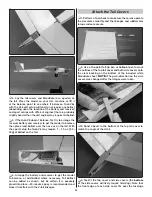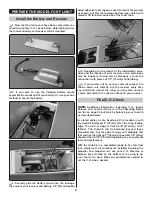
QUIK-V SERIES HISTORY
By Jim Allen
The original Quik-V made its debut back in 1987. It was
the fi rst shoulder-wing/V-tail combination for Quickie 500
racing. Back then, shoulder-wings were prevalent, but
only with conventional tails or T-tails. Doug Whitaker from
Tennessee was the fi rst person I saw with a V-tail, but his
plane had a low wing.
When I set out to make my own design, I not only wanted to
be different, but I felt a V-tail could fl y better by having most
of the tail in undisturbed air and one less drag-inducing
intersection between the tail and fuse. I also preferred the
high wing for less drag and improved stability—air travels
faster over the
top
of the wing than the bottom. Having the
draggy wing/fuse joint on the
bottom
of the wing places
it in the slower air for less drag. The shoulder wing also
doesn’t require dihedral, so it can be made one-piece for
increased strength for a given weight.
My fi rst Quik-V featured external pushrods and tip fences
to control airfl ow. It sure was stable!
The Quik-V2 debuted just before the 1990 Nats with a
new airfoil, a smaller V-tail and slimmed fuselage. In 1993,
the Quik-V3 debuted, again just before the 1993 Nats in
Lawrenceville, IL. V3 was one of the fi rst quickies to maximize
the aspect ratio by using a full, 52-inch span and the
narrowest cord possible to meet the just-over-500 square-
inch requirement. It also incorporated the upward-curved
wing tips still used on the Quik-V6! V3 also used another
new airfoil by Harry Riblet, who also described the tip shape
to me. With V3 we were beginning to see a consistent speed
advantage over the other quickies of the day—especially
when most races switched to the 608’ course in 1994.
In the winter of ’94-’95 I started working on the Quik-V4—
the fi rst version with concealed ruddervator linkages. Mike
Delponte did this a few years earlier on his
Revolution
and I fi nally got around to doing it on the Quik-V. We also
positioned the V-tail so that it exited the fuselage from the
corners—same as the Quik-V6 is today. V4 showed how
good the V3 wing really was. We had at least a 2-second
advantage on everybody! Gary Schmidt and I went to the
’95 Nats and were blowing everyone away. I ended up
getting a zero for a reason I’ve forgotten, but Gary went
on to win easily and I got fast time. We won a
LOT
with
these planes over the next few years! The following year
at the ’96 Nats, Gary and I tied for 1st and I won in a fl y-
off against him. Late in ’96, I acquired access to an airfoil
analysis program and went to work. The airfoil I came up
with went into the Quik-V5 that had all the attributes of V4
and an even further slimmed fuselage. Only three V5s were
built—one by me and two by Gary. Gary eventually lost
both of his, but I still have mine. We basically dominated
the 1999
Winterfest
race here in Phoenix, AZ. Last fall
at the Whittier 2014 October race, I pulled out that V5
and raced it just for giggles. I won 426 both days! Other
designs have caught up with the Quik-V5, but have not
passed it in performance—even with composite wings. It
took a couple more years for other airplanes to evolve
and begin to close the gap.
Beginning in 2002, I was wanting to focus more on QM. I
worked out a deal with Terence Palaschuk from Canada to
fl y his
Neme-Q
composite quickies and help him develop
his new version. Terence stopped making planes and
I’ve been gradually using up the ones I had. In addition,
our sport needed a new wood-and-foam quickie that is
competitive with the current crop of composite wing and
all-composite quickies. Most thought it was not possible
to win without a composite wing. So the Quik-V6 was
born and has clearly disproven that theory. The Quik-V6
incorporates everything I learned developing the previous
Quik-Vs and other race planes since. The structure was
designed with laser-cutting and ARF construction in
mind and uses my latest airfoil developed specifi cally
for the Quickies. It uses all the key features from the
previous versions with moments and tail areas for today’s
engines and equipment. The design has proven to be
dead-competitive and fl ies as good as or better than any
quickies today—even with MonoKote fi nish! Winning the
2014 Quickie Nats really sent that message home.
Back
Front
Backplate templates

































